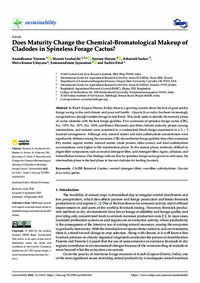Does Maturity Change the Chemical-Bromatological Makeup of Cladodes in Spineless Forage Cactus?

Authors:
In Kutch (Gujarat District, India), there is a growing concern about the lack of good quality forage owing to the arid climate and poor soil health. Opuntia ficus-indica has been increasingly recognized as a drought-resilient forage in arid Kutch. This study seeks to identify the maturity phase of cactus cladodes with the best forage qualities. Five accessions of spineless forage cactus (CBG, No. 1270, No. 1271, No. 1308, and Bianca Macomer) and three cladode maturity phases (young, intermediate, and mature) were examined in a randomized block design experiment in a 5 _ 3 factorial arrangement. Although only mineral matter and total carbohydrate concentration were significantly different among the accessions, CBG showed better forage qualities than other accessions. Dry matter, organic matter, mineral matter, crude protein, ether extract, and total carbohydrate accumulations were higher in the intermediate phase. In the mature phase, relatively difficult to digest fiber components such as neutral detergent fiber, acid detergent fiber, lignin, cellulose, and hemicellulose increase. Our findings indicate that for spineless forage cactus grown in arid areas, the intermediate phase is the best phase to harvest cladodes for feeding livestock
